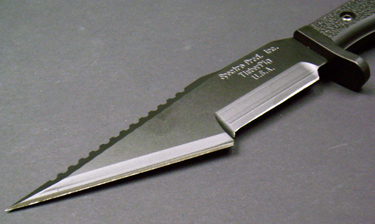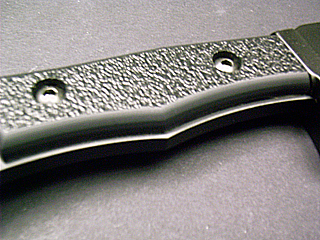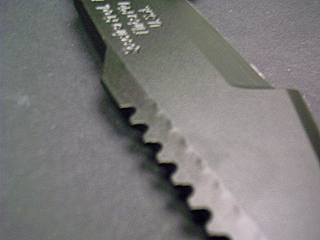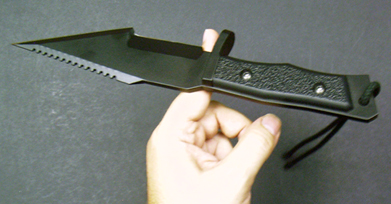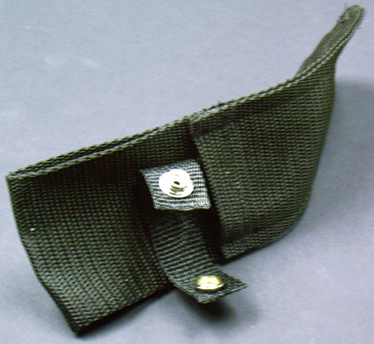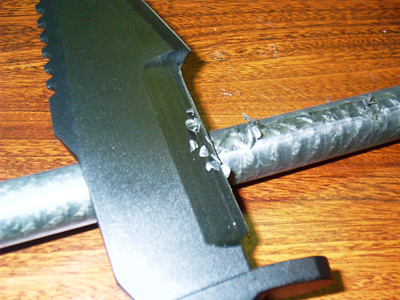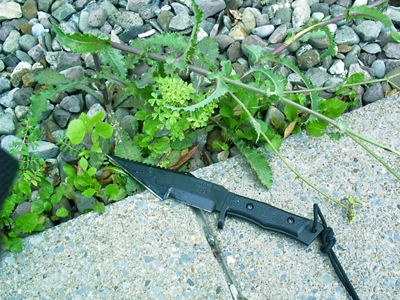its paid sponsors, whose products you need!
“Stay ‘unreasonable.’ If you
don’t like the solutions [available to you], come up with your
own.”
Dan Webre
The Martialist does not
constitute legal advice. It is for ENTERTAINMENT
PURPOSES ONLY.
Copyright © 2003-2004 Phil Elmore, all rights
reserved.
Spectre Products Timber Pig
A Product Review by Phil Elmore
I was thumbing through a popular knife magazine one evening
when an advertisement for the Spectre Products Timber Pig caught my
eye. Clearly intended as an outdoor work and survival knife, the Timber
Pig reminded me a little of the Tom
Brown Tracker that has been so popular since the release of The
Hunted.
The Timber Pig from Spectre Products.
The Martialist is nothing if not concerned with survival,
both urban and rural, so I phoned the company and asked them if they’d be
willing to submit a sample Timber Pig. The always friendly Pam Frye of
Spectre Products made the arrangements and put me in touch with Carl
Patterson, the man behind the knife.
I’m fairly certain that I was one of a handful of people in
the United States who was the first to get his hands on a production Timber
Pig. My sample came in a nylon blade cover sheath and had a coarse cord
lanyard attached. Carl informs me that paracord lanyards are standard on
the knives, but no paracord was available when mine was shipped.
Carl himself is a 42-year-old resident of Wauconda, IL,
whose background is in manufacturing management and engineering. Spectre
Products is a small company only recently founded, the culmination of Carl’s
childhood hobby designing knives.
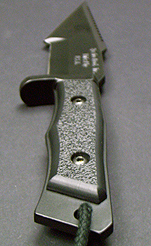
them,” Carl said while discussing the Timber Pig. “I would sketch and make designs for knives I wanted. I like working with steel,
so I started my career in manufacturing during my high school years. I’ve seen a lot of changes in manufacturing in the United States, much of which is not for the better. Demand for better quality in the United States came with a much higher price for not much better quality. Manufacturing management will always look at the profit margin to decide on quality, even if it means shipping substandard products in an effort to keep costs down. Manufacturers are having components made in China, Mexico etc., and marking it “Made in
USA.” Believe it or not, they are allowed to do that if only 40% of the product is made in a foreign land. Most of the affordable knives I didn’t like and the ones I did like, I couldn’t afford, so I decided to apply my ability in manufacturing to one of my life-long hobbies,
making knives.”
Manufactured right in Wauconda, Timber Pig blades are laser
cut and machined before being heat treated and epoxy-powder coated.
Roughly a foot overall, the knife is made of quarter-inch 1095 carbon
steel. The epoxy-powder coating is intended to prevent corrosion, while
the handle scales are textured, high-impact ABS.
The knife’s somewhat unusual name has an interesting story
behind it. “A few years back, while backpacking in the south,”
Carl explained, “a large wild boar came into my camp and looked very annoyed as he came toward me. I sprinted to the nearest tree; turned, and threw my
knife. It stuck in the pig’s shoulder bone. Halfway up the tree, when I looked back,
the pig waddled through the brush and timber snorting and thrashing. The knife got caught in the brush and pulled out. Then the
next pig came into camp. I learned two things while trying to sleep in
that tree. One was what to name my knife. The other was, don’t throw away your only means of defense unless you absolutely have to.”
The knife’s intended purposes are obvious in its
design. “When I made the knife for myself for backpacking,”
Carl told me, “I designed it so I
could combine a small hatchet into a knife with a good cutting edge. The
hatchet edge is straight for better chopping needs. The saw teeth are for notching wood
for slots to help secure sinew or twine when making woodcraft. The deeper
beveled edge is for any other cutting or whittling needs. The bevels are brought
to an edge by hand on a belt grinder, then hand-sharpened.”
I mentioned the similarity to the Tom Brown tracker.
“My original Timber Pig did not have the hatchet edge drop down below the
cutting edge,” Carl admitted, “but after seeing a photo of the Tracker with the drop on that
knife I did incorporate that part of it to help protect the finer edge. I have
never actually handled the Tracker, so I would not be able to compare it other
than with regard to what I’ve read about it in articles. The specifications of the blade
material itself are the same, though — quarter-inch 1095 heat treated carbon
steel.”
I asked Carl what is what like, designing and bringing the Timber Pig to
market. “The design was similar to a lot of knives I have made throughout the
years,” he said, “so for me that was the easy part. Getting it into production, like any
other new product in this day and age, was very difficult. Finding suppliers that
do a good quality job that didn’t want to overprice their services was the
hardest part, but we managed through it.”
Carl’s Timber Pig is the first in a series of what he hopes
to be six “Pig” knives. Three of these are intended to be
combat knives, including a “Desert Pig” tentatively scheduled for
release in September. The success of each Pig knife will determine the
release of future designs.
While I am a suburban fellow, not a rural guy, I tested the
Timber Pig thoroughly. The point of balance is forward of the guard,
making the knife blade-heavy (which is good for chopping). I have fairly
large ham-like hands, so the handle of the Timber Pig was only barely large
enough for me. That should, however, make it adequate for most
people. It is obviously a full-tang knife and feels substantial in the
hand.
The nylon blade cover is just that. For
heavy field use, an aftermarket Kydex or leather sheath would probably be
necessary. Carl explains that he does intend to improve the sheath in
the future, but
also wants to keep the cost of the knife down. There is no liner inside
the nylon cover shipped with my knife.
Carl asserts that the steep point of the Timber
Pig is good for drilling and that the knife can be used for light
digging. I used it to gouge out and widen a hole in tough Nylon 6/6 MDS
stock, a remnant of material used for synthetic fighting sticks. It did
fairly well against the slippery material.
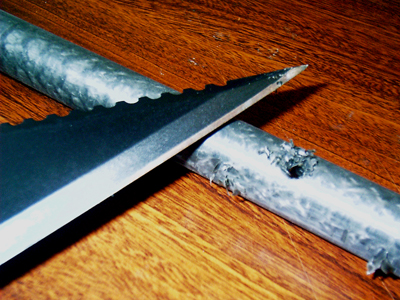
The hatchet portion of the knife also did
fairly well in shaving and chopping material from the shaft of Nylon 6/6 MDS,
which is fairly hard even though it is quite light.
To do some testing in outdoor conditions, I
created small holes, hacked light branches, and generally made a nuisance of
myself in the wooded area surrounding my office building. Over the
course of the week, I took several different runs at the build-up of knee-high
weeds in the alleyway behind the building. I deliberately did some
chopping through the moist underbrush early in the morning, then left the
Timber Pig at the bottom of my travel bag for several days.

the end of the week, I started making a pest of myself again, circling the
building and chopping down whatever I could. I deliberately left the
blade dirty each time.
I found that the angle between the primary edge
and the raised chopping section made a good “hook” for chopping down
weeds, snagging rope, and so on. The saw teeth on the back of the blade
are intended for catching material in this manner, of course, but the teeth on
my sample were not sharpened.
I asked Carl about this and he told me that
initially, he wasn’t certain about the knife laws in his state. He did
not sharpen the teeth on the first few Timber Pigs for fear of producing
“double-edged knives” illegally. When I last spoke with him he
was in the process of confirming his local laws so that future knives could
have deeper, sharper teeth.
My Timber Pig made a positive mess of the tall
weeds and other brush around the building, performing all tasks I asked of
it. The 1095 carbon steel did rust,
as I was trying to make it do, but the epoxy-powder coating protected the rest
of the knife. Simply touching up the edge would be enough to sharpen
away the rust on the blade.
The Timber Pig has been advertised in Tactical
Knives magazine. As of this writing, ads are scheduled to appear in Back
Woods Home and Blade as well. Those interested in the Timber
Pig or other Spectre Products blades can call 1-888-61-KNIVES or mail
postal inquiries to:
Spectre Products, Inc.
PO Box 6161
Wauconda, IL
60084
“It’s been suggested,” Carl Patterson
told me, “that the Timber Pig be made of stainless steel with Linen
Micarta handles and a more expensive sheath. That would drive up the cost, which the consumer always pays. Spectre
Products’ Timber Pig and future products will remain affordable.
“I’m a consumer too, and feel I shouldn’t have to pay more
for a knife just because it’s marked Made in the USA.”


